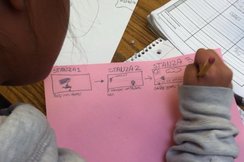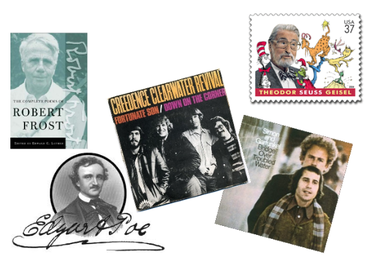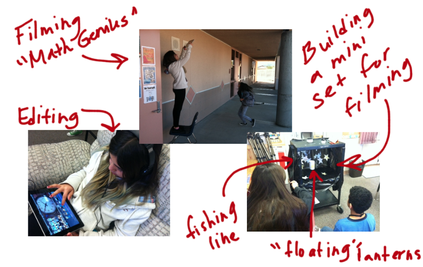|
Middle schoolers have a unique outlook on the world. They are not quite adolescents, yet could not be mistaken for elementary kids either. Capturing their interest and truly engaging them in the learning process can be tricky at best. Sometimes, it seems near impossible. For example, a unique challenge of teaching in the desert of Southern California, is that whenever the weather changes - students inevitably go a little bit crazy. In the land of constant sunshine, a cloudy day, strong winds, or - most shockingly of all - some actual raindrops can bring instruction to a grinding halt. So, when it came time to teach poetry this year and we happened to be smack in the middle of a cloudy and rainy couple of days - I knew I needed to deliver an unforgettable exploration of poetry. Since songs are poetry set to music, I decided to tap into one of my favorites: Starting off by reading In the Ghetto was a good decision. About 80% of the students at my school site come from socio-economically disadvantaged families, and I seem to have a higher than average amount of students this year who are bussed in from a neighborhood known for its gang affiliations. The content of In the Ghetto surprised them - they are used to hearing Elvis' more lighthearted classics play over the loudspeaker at the local water park during the hot summer months. But they were entirely unfamiliar with this song, which quickly and understandably struck a chord. We read the lyrics using the Four Voices strategy. This consists of breaking text into meaningful chunks and color-coding it in four different colors. Each student in a group assumes a color to read and this aids in their overall comprehension of the poetry text. Afterward, I used In the Ghetto as a model text. On clean copies of the poem, we worked as a class to paraphrase each stanza and color-code literary devices. Discussions about tone and mood evolved naturally during the paraphrasing process, and I was delighted to see that engagement was through the roof thanks to the use of Today's Meet. When all was said and done, I played the song so students could hear it. They loved it! To repeat the process, while gradually releasing control until students could execute the read/paraphrase/analyze process on their own, I busted out some other major players in poetry and music. Whenever possible, I shared the songs or You Tube fan tributes in class after reading. (For example, there's a fantastic fan tribute for Annabel Lee on You Tube, which really helped cement understanding for my EL students.)  After our poetry exploration, which included a day of poetry-themed learning centers, I asked students to attempt to write their own poems individually. In groups, students selected their favorites and planned iMovies to illustrate their poems. Since students have previously engaged in digital storytelling, the storyboarding process was very successful at keeping groups on track and focused. The poems were read as voice-overs and some groups chose to add music, while others preferred to deliver their poems slam style. Here are a few of their finished poetry movies: So, what do you get when you combine Elvis, Poe, CCR, Seuss, Simon & Garfunkle, and Frost? Magic for sixth graders learning about poetry!
2 Comments
Lynn Woods
2/24/2013 05:35:41 pm
Thanks for this great idea. You have inspired me to try a unit of poetry like this with my 8th graders!
Reply
2/25/2013 02:33:39 am
Thanks for reading, Lynn. I'm glad you're going to give some of this a try with 8th graders. Let me know how it goes and if you do anything differently. I'm always up for revising/refining plans!
Reply
Your comment will be posted after it is approved.
Leave a Reply. |
Author: Jessica PackCalifornia Teacher of the Year. CUE Outstanding Educator 2015. DIGICOM Learning Teacher Consultant. 6th Grade Teacher. Passionate about gamification, Minecraft, digital story-telling, and fostering student voices. Download:Archives
June 2020
Categories
All
|




 RSS Feed
RSS Feed